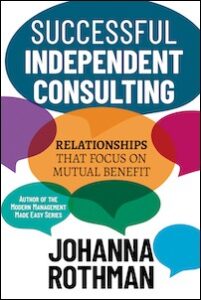 Much of my LinkedIn and Twitter feeds have questionnaires with two or three choices. One of those choices contains the One Right Answer. All the other answers are Wrong.
Much of my LinkedIn and Twitter feeds have questionnaires with two or three choices. One of those choices contains the One Right Answer. All the other answers are Wrong.
Or, a person poses a question that's supposed to show that they—and they alone—know the answer to the question. (I ranted about one of those on my other blog. See Which Assumptions Do You Bring to What You Read? (& My Recent Experience).)
When consultants ask these questions, the consultants assume they are showing their unique value.
Nope. They're showing how they only offer commodity, and too often, inadequate, consulting. That's for several reasons:
- There are almost always at least three reasonable solutions or answers to a given problem.
- When I see an interesting problem, I almost always need to say, “It depends…” and then delve into a deeper discussion. That's because very few problems have simple or “best practice” answers.
- Most problems need critical thinking skills because what works for one client does not work for another. (See the “it depends” answer.)
Worse, these consultants give all consultants a bad name. And all because they don't understand their possible business models.
Business Models Explain How to Make Money
 Business models help you understand how you or your company make money. Consultants have four axes in their business model, as in the image on the left.
Business models help you understand how you or your company make money. Consultants have four axes in their business model, as in the image on the left.
In the upper two quadrants, consultants can offer their unique expertise in a variety of forms. For example, people know me for my expertise in managing product development. I offer blog posts, conference talks, and meetups in the low-fee, commodity experience quadrant. My books are a slightly higher fee, but showcase my experience and explain how the reader can succeed. I offer custom workshops to my clients at a much higher fee.
Let's talk about one example of what people expect of consultants: facilitation skills.
- Lower left quadrant: I often facilitate the Q&A at the end of my free talks. I do this to make it easy on my hosts who often do not know how to stack the questions.
- Upper left quadrant: I show various facilitation techniques in my free talks.
- Upper right quadrant: I customize strategic action and portfolio decisions with my clients. As a consultant, I use various facilitation techniques to discover the real issues. Sometimes, those facilitation techniques are part of a workshop, but more often as consulting. Because people receive high-value outcomes, I can charge a higher fee.
Consultants aren't alone in this way of thinking about their business model. Almost every company has low-fee, often introductory offerings, so “everyone” can be a customer. And almost every company has higher-fee offerings that capitalize on their unique value.
When those consultants ask One Right Answer questions, they show that they are only capable of offering a commodity experience. That comes with the requisite low fee.
Consultants can change their business models and get better clients with higher fees.
Assess Your Business Model
If you are a consultant, review all your offerings. (I explain how in Successful Independent Consulting.) For example, if you only offer certification classes, what differentiates you from all the other people who do the same thing? If you don't have an answer to that, you will see continual price pressure down on your fees. There are several reasons for that:
- Many of the certification bodies set up the certification as a Ponzi scheme. You need to retain your ability to teach by teaching, so you might take more people in your classes, just to make sure the class runs. And people need to keep their certification with continuing education, but that does not require a class.
- The more people have the certification, the fewer people need training. So there's more pressure on you to reduce your fees to fill the classes.
- The certification itself loses its value as more people get it.
When I started my business, I did take interim management roles, which were not quite commodity offerings. I added value by running internal workshops on how to hire my replacement manager. So even though I charged by the hour for that work (which I would never do now!), I still differentiated myself.
As you review your offerings, place them in the various business model quadrants. Now, how many of your offerings show your unique value, something that differentiates your work from other people's work? If the answer is “not enough,” take some time and develop different offerings. And write content about those offerings.
Attract Clients with Content Marketing
The consultants who offer those questionnaires are trying to do content marketing. But they're not succeeding.
Instead of those questionnaires, they could write several posts or articles about the possible answers to those questions and when to use each answer. That would show other people how their consulting expertise differs from anyone else's expertise.
That requires investing in yourself before you invest your time in your client's changes.
This is one of an intermittent series of consulting tips.
(Interested in the consulting workshop later this year? See the Successful Independent Consulting Workshop page for the details and to subscribe to a notification list. I'm thinking of how to make this workshop several workshops so prospective consultants can succeed better.)